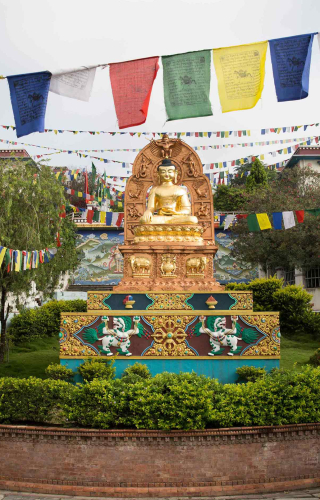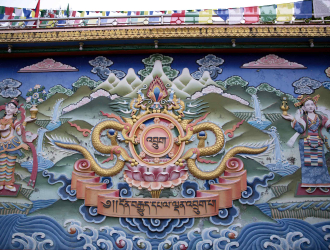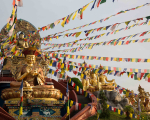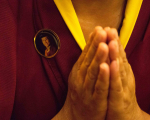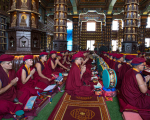It was 4:30 in the morning and the air was chilly. My cab was making its way up the Druk Amitabha Mountain. The journey was slow, albeit peaceful, winding along the steep, narrow hillside road. Out in the distance, Kathmandu Valley was still asleep. As we climbed up higher and higher, so did my anticipation. I had been long waiting for this day—the day I would finally get to meet the Kung Fu Nuns of the Drukpa Order in Kathmandu.
The Druk Amitabha Mountain is locally known as the Seto (White) Gompa. It is the location of the Druk Gawa Khilwa Abbey, the primary nunnery within the Drukpa lineage. Three other Druk Gawa Khilwa branches are located in India—at Kortsa and Shey in Ladakh, and at Lahaul in Himachal Pradesh. The Kathmandu nunnery was established with 15 young Ladakhi nuns in 1992, largely a result of the efforts of the current Gyalwang Drukpa (head of the Drukpa lineage), Jigme Pema Wangchen. His Holiness the Gyalwang Drukpa has been a champion of women’s education and empowerment for decades. He elaborates his vision in these words:
Everyone, whether man or woman, has the potential and the right to attain Buddhahood. Unfortunately, for many generations, not only in Tibet or Ladakh, but in fact throughout the world, women have not been treated fairly. I started Druk Gawa Khilwa mainly to lift the status of female practitioners in my small community. I feel that I am responsible for the well-being and spiritual progress of both monks (bhikkhus, the male practitioners) and nuns (bhikkhunis, the female practitioners). I did not start this with a great ambition of promoting female rights or [as a] movement. I just thought that at least my community of nuns should not suffer unfair treatment due to social or cultural discrimination that has existed for so many generations.
When I reached Druk Amitabha Mountain, I was greeted by a group of cheerful nuns whose warmth and generosity stayed with me long after my visit ended. On arrival, I was directed to meet Jigme Chosdon, who became a guide, friend and constant companion during my time at the nunnery. Jigme Chosdon is from Nubra in Ladakh. She joined the nunnery in 2003 when she was 29 years old. Like many others, her decision to become a bhikkuni was met with opposition from her parents, but they eventually let her join the nunnery at Ladakh where she received her initial training. I also developed a close relationship with Jigme Choeky, nicknamed Renu. She met His Holiness the Gyalwang Drukpa when she was studying in the 10th standard at a school in Kinnaur in Himachal Pradesh. Inspired by him, from 2000 onwards she immersed herself in Buddhist studies and decided to become a nun. She joined the Kathmandu nunnery in 2005. She told me that at the nunnery she realised the true meaning of life, and that His Holiness had shown her the right path. This, she said, was a result of her previous life’s good karma. Over the two weeks of my interaction with the nuns, I met many extraordinary women like Jigme Chosdon and Jigme Renu, who had committed themselves to the pursuit of enlightenment by practising a life of compassion and selfless service.
Today, the Druk Gawa Khilwa is home to more than 500 nuns from across the Himalayan region. Life at the nunnery starts as early as 3 am with prayers and meditation. The day unfolds in Buddhist religious studies and in learning the rituals that have to be performed during important ceremonies. Throughout the day, teams of nuns also manage the running of the nunnery, provide medical and veterinary services, operate a clinic, a souvenir store and a guesthouse, maintain three greenhouses, and harvest solar energy. The life of the nuns revolves around extending help to those who are less fortunate while also working towards making themselves self-sufficient in all aspects of existence.
Part of attaining self-sufficiency involves physical training through the daily practice of kung fu. Martial arts training, including the handling of weapons, plays a key role in developing concentration, discipline, self-esteem, perseverance, respect for others and a healthy lifestyle.The nuns are trained by Jigme Rigzang, a Vietnamese kung fu trainer. He travels to Nepal twice a year to personally train the nuns. According to him, ‘Since the nuns meditate daily, they are able to concentrate much more during kung fu. Besides self-defense, learning kung fu also helps them develop mental and emotional strength.’
However, the physical training of Druk Gawa Khilwa’s nuns is not limited to kung fu. The nuns are active cyclists, and through their yearly Cycle Yatras across Nepal and India they raise awareness about gender equality, environmental problems and human trafficking. Cycling is undertaken daily by a rotating group of 20 nuns. Instead of their maroon robes, the cyclist nuns are dressed in shorts, t-shirts and their cycling gear. They start out at 4 am and make a five-hour-long cycling tour down the hills, picking trash and rescuing animals along the way. Jigme Renu says, ‘Cycling is meditation for us. It helps us clear our minds. While we are riding our bicycle, we also recite our prayers.’
Interestingly, I noticed that all the nuns had the prefix Jigme attached to their names. Upon inquiry, I was told that jigme means ‘fearless’ in Tibetan. And jigme they are. Through their various initiatives, the nuns are championing physical fitness and sustainable living, and challenging stereotypes of pre-fixed gender roles, even within an orthodox religious institution. I see the kung fu nuns as an important part of a larger narrative about women’s empowerment in South Asian cultures and countries. As a visual artist, that is a project in which I am deeply interested. I hope to join these strong-willed women during their Cycle Yatra from Kathmandu to India someday, and continue documenting their incredible lives.
